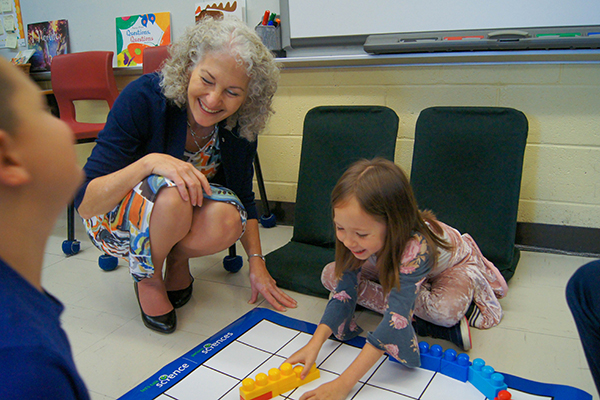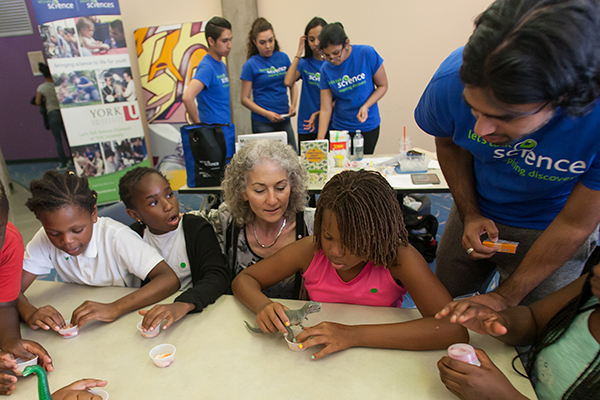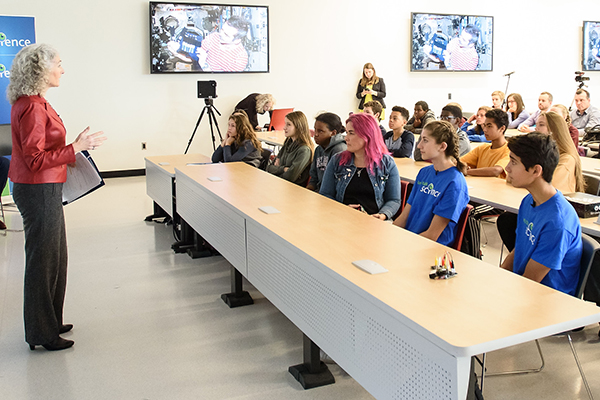Celebrating 30 Years of Let’s Talk Science: President and Founder, Dr. Bonnie Schmidt, on Humble Origins and Hopeful Tomorrows
The economic recession of the early 1990s hit scientific research hard—there were cuts to funding, grants disappeared, and, because there is very little public outreach, the negative impacts were not recognized by the public. It was a time of uncertainty, and in the science community, the recession forced some hard questions about whether the public valued scientific research. While this was happening, in 1991, Bonnie Schmidt was working towards her PhD in Physiology at Western University in London, Ontario. Having changed paths after failing the manual carving test on the Dental Aptitude Test—twice—Schmidt was still figuring out exactly where she wanted her life to go when she began noticing the division between the metaphorical town and gown. She started bridging that divide by mobilizing university students to bring science into classrooms across their community. With just a handful of graduate students and support from some key mentors, Schmidt began to lay the foundation for what would become the national, award-winning, charitable organization Let’s Talk Science.
“I started a small outreach project with some grad students in physiology at Western in the London community, and it grew really quickly,” recalls Schmidt. “It started because of the decline in research funding and wanting to promote research and help people understand its role and value.” Despite the ravenous appetite on both the student and community side, getting the program off the ground did not come without its hurdles. At the time, Schmidt was completing her PhD while also working as a teaching assistant and bartending at a local Irish pub, leaving her little time for other ventures. “I'm not a community organizer at heart. It was not at all that I was trying to change the world,” she admits candidly. “For me, it was clear that something was missing from the community—access between the science and education communities—and I thought I could do something about it.” Instead of trying to do everything herself, Schmidt focused on pairing interested grad students with teachers in the community and letting them experiment with what worked best.

In 1993, while she was wrapping up her doctorate degree, Schmidt was approached by a colleague, Dr. Barbara Vanderhyden, from the University of Ottawa who had been a PhD student a few years ahead of her at Western University. She had heard about and was looking to replicate her outreach success. At the same time, another professor—this time from Queen’s University—had heard about the program and was asking the same thing. “Those requests led me to create the first operations manual,” says Schmidt. This manual helped other institutions start building their outreach centers to join what was then called the Partnership Program and is now Let’s Talk Science Outreach. “Around the same time as the interest from other universities started growing, I was offered funding from the Lawson Foundation,” says Schmidt. “This allowed me to focus full time on Let’s Talk Science once I graduated, and that's why we anchor September 1993 as the official start of the organization.” From those three sites in 1993, Let’s Talk Science Outreach has since expanded to over 55 universities, colleges and research institutes, spanning the entire country.

While the organization’s original focus was on raising interest in science as the endpoint, that goal became more sophisticated. “It didn't take long for us to realize the value of science engagement as a learning platform – building on kids’ natural curiosity,” says Schmidt. It was subtle, but the really important shift was when it changed from: 'I'm going to teach you about DNA,' to: 'I'm going to use science to get you interested in the world around us.'” Now, Let’s Talk Science focuses on helping youth prepare for work and citizenship roles through STEM engagement. “Another aspect that evolved is our recognition of the importance of helping kids think about career and post-secondary pathways far earlier in life,” says Schmidt. “We recognize that many people outside of advanced STEM studies continue to have stereotypical and traditional ideas of what you can do with a STEM background. We want to tackle barriers and stereotypes by putting a real face to science for young people and highlight the many opportunities available to those with STEM experience.”
Let’s Talk Science’s goal has always been impacting every young person across the country. Whether in metropolitan centres, rural areas, Indigenous communities, or the far north, the organization strives to make everyone feel included and engaged. “From the very beginning, the perspective has been ‘there are so few kids in Canada, how do we engage everybody?’ and with that mindset came the recognition that we needed to go to them,” says Schmidt. “As we've gotten smarter and learned more about historical issues and ongoing injustices, the organization has become even more intentional with our approach. Now we say "We know we want to be inclusive, so let's get intentional in identifying and talking about systemic barriers and figure out what supports and resources are needed to overcome them.'” Today, Let’s Talk Science partners with several different organizations to engage equity-deserving youth, including United for Literacy, BGC Canada, San Romanoway Revitalization Association, Canadian Black Scientists Network, IDEA-STEM, Imhotep’s Legacy, and others.

Over the years, there have certainly been ups and downs, but one of the biggest successes that Schmidt recognizes is the popularization of Let’s Talk Science’s mission. “The STEM acronym didn’t exist 15-20 years ago and attitudes towards STEM weren’t great,” points out Schmidt. “We were very early players and one of the only national groups thinking about role models and science engagement with youth and educators.” Now, almost everyone understands that STEM stands for science, technology, engineering and mathematics, and you can find STEM-themed summer camps, computer games, and toys everywhere. “In many jurisdictions, the science curriculum is evolving but slowly and more needs to be done. We are inspired to consider how we can support the development of forward-looking education curricula that keep pace with the rapid changes in the world.”

Science education has shifted over the past 30 years and continues to change. Schmidt sees climate change and sustainability becoming a major focal point in STEM education and a move towards the sciences being more interdisciplinary. “Science class will not be about memorizing content, but will shift more towards understanding the processes of science and the application of science to solve problems,” predicts Schmidt. As far as Let’s Talk Science is concerned, she hopes the organization can remain on a sustainable growth path. “Our vision is still to positively impact every child in the country, so we have a ways to go,” she says. “We're in about a third of schools right now and accessed in over 1,600 communities. We want Let’s Talk Science to be a first stop for all teachers in every school, and for every child in the country to connect with our programming and experience what we have to offer.”
Let’s Talk Science has come a long way in the 30 years since Bonnie Schmidt first saw the opportunity to connect with her community through science. With partnerships with over 55 universities, colleges and research institutes, a world-class volunteer network, over 100 full-time staff, and over 16 million interactions with youth, educators and parents since 1993, Let’s Talk Science is ready to tackle the next 30 years. Schmidt believes that all young people can benefit from understanding the processes and applications of science to help them think more critically about the world, even if they're not thinking about higher education or a career in STEM. And for those just getting into science, Schmidt has some words of advice: “Have fun with it! Drop the acronym, get your hands dirty, and see how you can grow into an explorer using STEM tools to learn about and influence the world. That's what it’s all about!"
Let's Talk Science is celebrating our 30th Anniversary and we are excited to continue making an impact in the lives of children and youth across Canada for another 30 years - or longer.
Join us in shaping the future by contributing to our fundraising goal of raising $30 Million in three years from industry, individuals and foundations through our Inspire – Educate – Innovate Fundraising Campaign. Together, we can continue to make a difference.